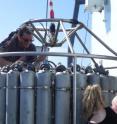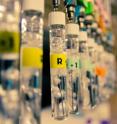Study resolves controversy over nitrogen's ocean 'exit strategies'
A decades-long debate over how nitrogen is removed from the ocean may now be settled by new findings from researchers at Princeton University and their collaborators at the University of Washington. The debate centers on how nitrogen -- one of the most important food sources for ocean life and a controller of atmospheric carbon dioxide -- becomes converted to a form that can exit the ocean and return to the atmosphere where it is reused in the global nitrogen cycle.
Researchers have argued over which of two nitrogen-removal mechanisms, denitrification and anammox, is most important in the oceans. The question is not just a scientific curiosity, but has real world applications because one mechanism contributes more greenhouse gases to the atmosphere than the other.
"Nitrogen controls much of the productivity of the ocean," said Andrew Babbin, first author of the study and a graduate student who works with Bess Ward, Princeton's William J. Sinclair Professor of Geosciences. "Understanding nitrogen cycling is crucial to understanding the productivity of the oceans as well as the global climate," he said.
In the new study, the researchers found that both of these nitrogen "exit strategies" are at work in the oceans, with denitrification mopping up about 70 percent of the nitrogen and anammox disposing of the rest.
The researchers also found that this 70-30 ratio could shift in response to changes in the quantity and quality of the nitrogen in need of removal. The study was published online this week in the journal Science.
The two other members of the research team were Richard Keil and Allan Devol, both professors at University of Washington's School of Oceanography.
Essential for Earth's life and climate, nitrogen is an element that cycles between soils and the atmosphere and between the atmosphere and the ocean. Bacteria near the surface help shuttle nitrogen into the ocean food chain by converting or "fixing" atmospheric nitrogen into forms that phytoplankton can use.
Without this fixed nitrogen, phytoplankton could not absorb carbon dioxide from the air, a feat which is helping to check today's rising carbon dioxide levels in the atmosphere. When these tiny marine algae die or are consumed by predators, their biomass sinks to the ocean interior where it becomes food for other types of bacteria.
Until about 20 years ago, most scientists thought that denitrification, carried out by some of these bacteria, was the primary way that fixed nitrogen was recycled back to nitrogen gas. The second process, known as anaerobic ammonia oxidation, or anammox, was discovered by Dutch researchers studying how nitrogen is removed in sewage treatment plants.
Both processes occur in regions of the ocean that are naturally low in oxygen, or anoxic, due to local lack of water circulation and intense phytoplankton productivity overlying these regions. Within the world's ocean, such regions occur only in the Arabian Sea, and off the coasts of Peru and Mexico.
In these anoxic environments, anaerobic bacteria feast on the decaying phytoplankton, and in the process cause the denitrification of nitrate into nitrogen gas, which cannot be used as a nutrient by most phytoplankton. During this process, ammonium is also produced, although marine geochemists had never been able to detect the ammonium that they knew must be there.
That riddle was solved in the early 2000s by the discovery of the anammox reaction in the marine environment, in which anaerobic bacteria feed on ammonium and convert it to nitrogen gas.
But another riddle soon appeared: the anammox rates that Dutch and German teams of researchers measured in the oceans appeared to account for the entire nitrogen loss, leaving no role for denitrification.
Then in 2009, Ward's team published a study in the journal Nature showing that denitrification was still a major actor in returning nitrogen to the air, at least in the Arabian Sea. The paper further fueled the controversy.
Back at Princeton, Ward suspected that both processes were necessary, with denitrification churning out the ammonium that anammox then converted to nitrogen gas.
To settle the issue, Ward and Babbin decided to look at exactly what was going on in anoxic ocean water when bacteria were given nitrogen and other nutrients to chew on.
They collected water samples from an anoxic region in the ocean south of Baja California and brought test tubes of the water into an on-ship laboratory. Working inside a sturdy, flexible "glove bag" to keep air from contaminating the low-oxygen water, Babbin added specific amounts and types of nitrogen and organic compounds to each test tube, and then noted whether denitrification or anammox occurred.
"We conducted a suite of experiments in which we added different types of organic matter, with variable ammonium content, to see if the ratio between denitrification and anammox would change," said Babbin. "We found that not only did increased ammonia favor anammox as predicted, but that the precise proportions of nitrogen loss matched exactly as predicted based on the ammonium content."
The explanation of why, in past experiments, some researchers found mostly denitrification while others found only anammox comes down to a sort-of "bloom and bust" cycle of phytoplankton life, explained Ward.
"If you have a big plankton bloom, then when those organisms die, a large amount of organic matter will sink and be degraded," she said, "but we scientists are not always there to measure this. In other words, if you aren't there on the day lunch is delivered, you won't measure these processes."
The researchers also linked the rates of nitrogen loss with the supply of organic material that drives the rates: more organic material equates to more nitrogen loss, so the quantity of the material matters too, Babbin said.
The two pathways have distinct metabolisms that turn out to be important in global climate change, he said. "Denitrification produces carbon dioxide and both produces and consumes nitrous oxide, which is another major greenhouse gas and an ozone depletion agent," he said. "Anammox, however, consumes carbon dioxide and has no known nitrous oxide byproduct. The balance between the two therefore has a significant impact on the production and consumption of greenhouse gases in the ocean."
Source: Princeton University
Other sources
- Controversy over nitrogen's ocean 'exit strategies' resolvedfrom Science DailyFri, 11 Apr 2014, 20:20:43 UTC
- Study resolves controversy over nitrogen's ocean 'exit strategies'from PhysorgFri, 11 Apr 2014, 13:02:26 UTC

